Comprehensive Report on Managing Food Production at Ledbury Restaurant
VerifiedAdded on 2023/01/18
|10
|2900
|44
Report
AI Summary
This report provides a comprehensive analysis of food production, focusing on the operations of Ledbury Restaurant. It begins by explaining different food preparation and production systems, including cook chill, cook freeze, and sous vide methods, and then delves into the factors that influence the design of these systems. The report outlines key principles for planning food preparation and production, such as hazard analysis and establishing critical control points, as well as various planning methods like training plans and conventional approaches. It identifies the essential resources required for consistent and timely food production, including human, physical, financial, and technical resources, and details effective resource management processes. The report also explores standard operating procedures (SOPs) for food production, emphasizing supplier selection and the use of personal protective equipment. Finally, it examines various methods for monitoring food production, such as stock rotation, record inspection, and budgetary targets, and discusses the effects of deviations from established processes and procedures. The report concludes with a summary of the key findings and recommendations for optimizing food production processes in the context of a hospitality setting.
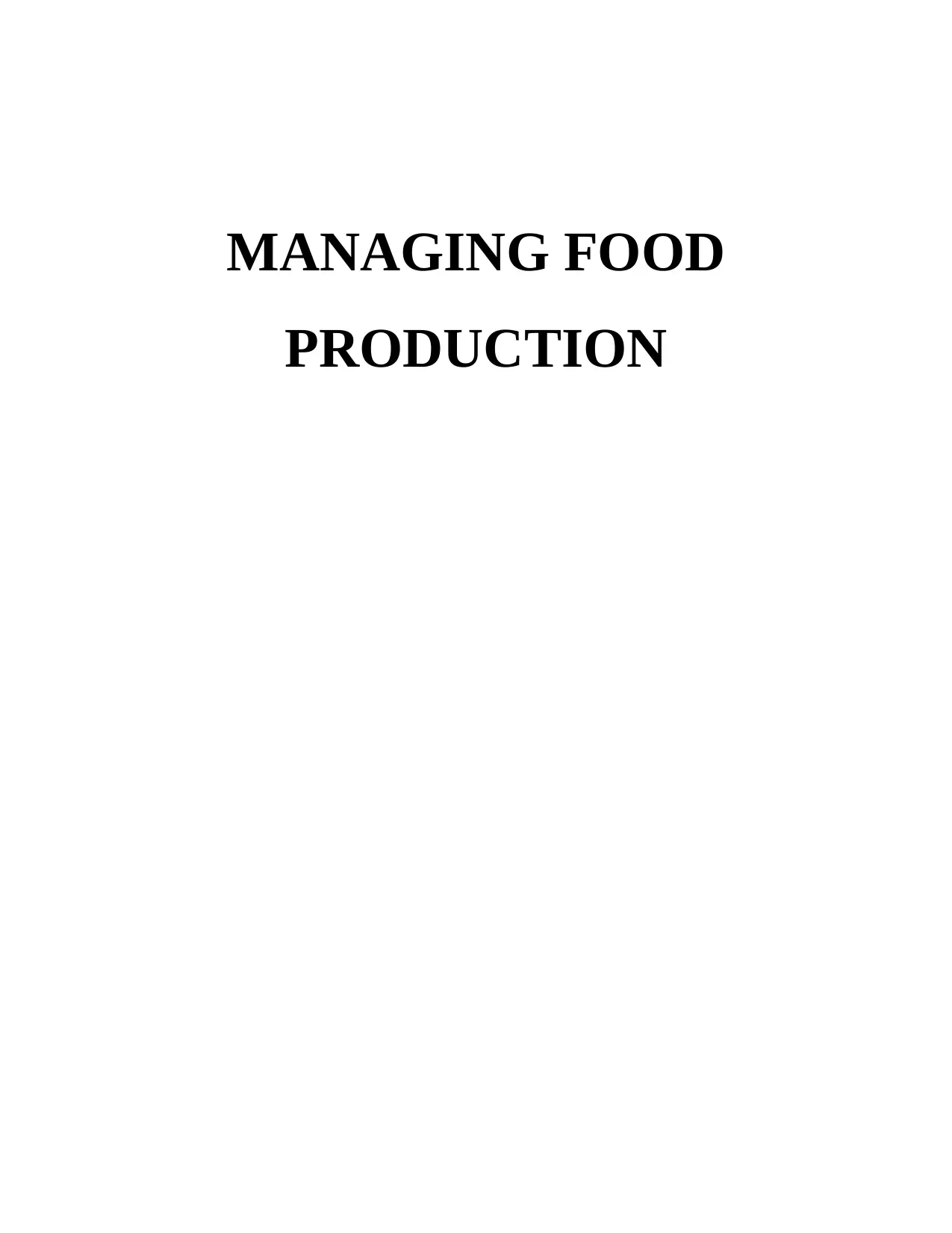
MANAGING FOOD
PRODUCTION
PRODUCTION
Paraphrase This Document
Need a fresh take? Get an instant paraphrase of this document with our AI Paraphraser
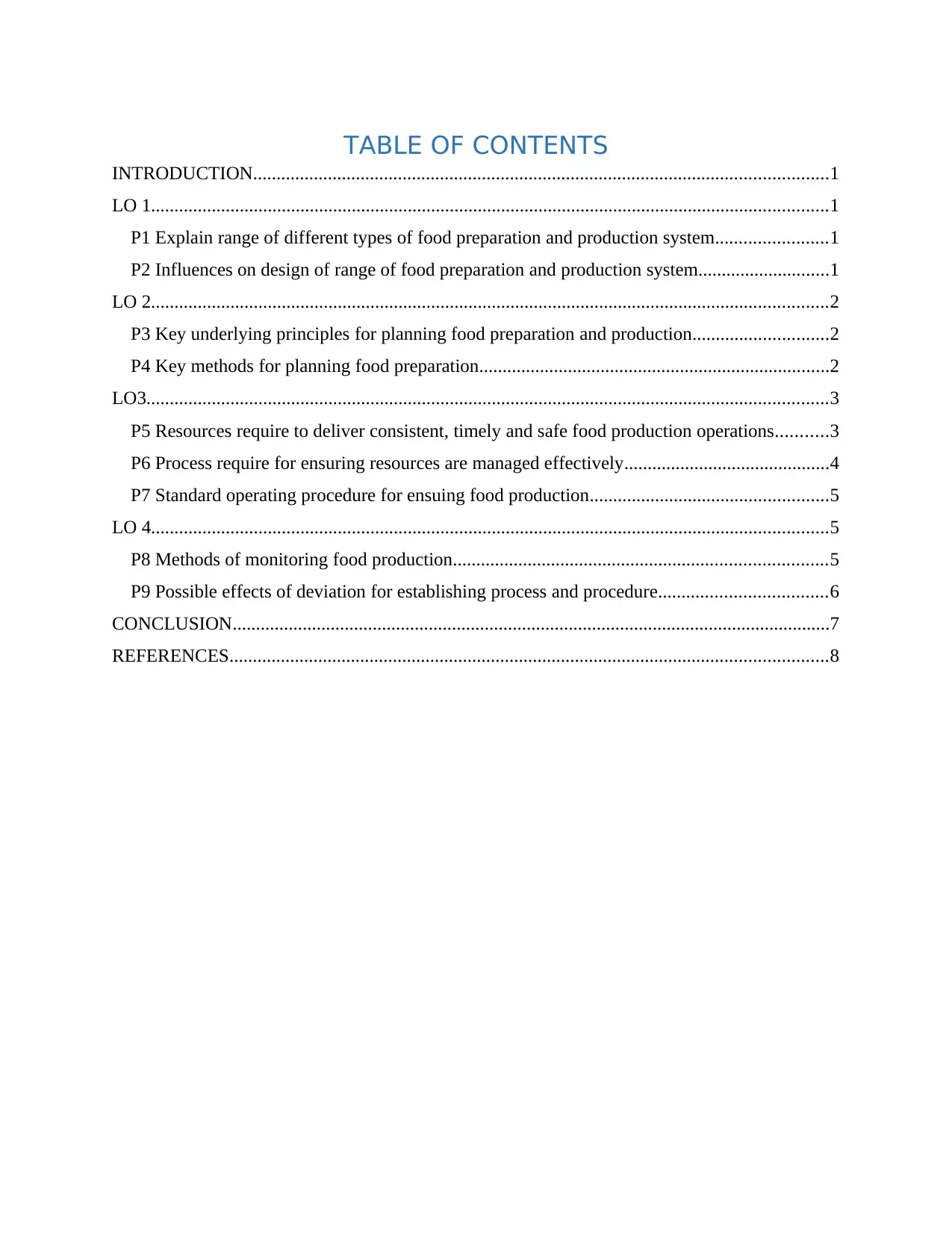
TABLE OF CONTENTS
INTRODUCTION...........................................................................................................................1
LO 1.................................................................................................................................................1
P1 Explain range of different types of food preparation and production system........................1
P2 Influences on design of range of food preparation and production system............................1
LO 2.................................................................................................................................................2
P3 Key underlying principles for planning food preparation and production.............................2
P4 Key methods for planning food preparation...........................................................................2
LO3..................................................................................................................................................3
P5 Resources require to deliver consistent, timely and safe food production operations...........3
P6 Process require for ensuring resources are managed effectively............................................4
P7 Standard operating procedure for ensuing food production...................................................5
LO 4.................................................................................................................................................5
P8 Methods of monitoring food production................................................................................5
P9 Possible effects of deviation for establishing process and procedure....................................6
CONCLUSION................................................................................................................................7
REFERENCES................................................................................................................................8
INTRODUCTION...........................................................................................................................1
LO 1.................................................................................................................................................1
P1 Explain range of different types of food preparation and production system........................1
P2 Influences on design of range of food preparation and production system............................1
LO 2.................................................................................................................................................2
P3 Key underlying principles for planning food preparation and production.............................2
P4 Key methods for planning food preparation...........................................................................2
LO3..................................................................................................................................................3
P5 Resources require to deliver consistent, timely and safe food production operations...........3
P6 Process require for ensuring resources are managed effectively............................................4
P7 Standard operating procedure for ensuing food production...................................................5
LO 4.................................................................................................................................................5
P8 Methods of monitoring food production................................................................................5
P9 Possible effects of deviation for establishing process and procedure....................................6
CONCLUSION................................................................................................................................7
REFERENCES................................................................................................................................8

INTRODUCTION
Food production is considered as essential element of food service operations. This directly
impacts on the profitability of firms that are operating in hospitality industry (Dauber and
Miyake, 2016). Present study is based on Ledbury restaurant that serves British cuisine. It is
medium size restaurants that closely concentrates offering satisfactory services to wide range of
consumers. Current assignment will explain various food preparation system. It will describe
principles of food production. In addition, study will highlight monitoring methods of food
production.
LO 1
P1 Explain range of different types of food preparation and production system
Food production can be described as process of preparing food by using various methods.
There are several ways of preparing food. These are explained as below:
Cook Chill system
This is the production system in which food is being prepared normally. Rapid chilling is
done then it is being stored in low temperature. It is stored at 0 degree C to 3 degree C. Once it
is stored then food is reheated again before its consumption (Jianyi and et.al., 2015).
Cook freeze method
This is another type of production system in which food is being cooked by using fast
freezing technique, kitchen staff store that food at 18 C temperature. As this method is helpful in
keeping food safe and fresh for longer duration.
Sous vide method
This is another kind of production or preparation system in which food is kept in the
temperature of 70C and kitchen staff cook the actual material in vacuum plastic bags. Water bath
machines are used in preparing this food. This is the system that helps in improving texture and
flavour of the food to great extent (Lassa, Lai and Goh, 2016).
P2 Influences on design of range of food preparation and production system
There are several factors that have influence on design of food production system.
Type of cuisine offered by restaurant: As if customers are demanding the new items
according to season then enterprise has to make changes in its existing process or
production system in order to meet demand of guests in the Ledbury restaurant. As many
times restaurant uses cook freeze method but if customer is demanding the sea food then
1
Food production is considered as essential element of food service operations. This directly
impacts on the profitability of firms that are operating in hospitality industry (Dauber and
Miyake, 2016). Present study is based on Ledbury restaurant that serves British cuisine. It is
medium size restaurants that closely concentrates offering satisfactory services to wide range of
consumers. Current assignment will explain various food preparation system. It will describe
principles of food production. In addition, study will highlight monitoring methods of food
production.
LO 1
P1 Explain range of different types of food preparation and production system
Food production can be described as process of preparing food by using various methods.
There are several ways of preparing food. These are explained as below:
Cook Chill system
This is the production system in which food is being prepared normally. Rapid chilling is
done then it is being stored in low temperature. It is stored at 0 degree C to 3 degree C. Once it
is stored then food is reheated again before its consumption (Jianyi and et.al., 2015).
Cook freeze method
This is another type of production system in which food is being cooked by using fast
freezing technique, kitchen staff store that food at 18 C temperature. As this method is helpful in
keeping food safe and fresh for longer duration.
Sous vide method
This is another kind of production or preparation system in which food is kept in the
temperature of 70C and kitchen staff cook the actual material in vacuum plastic bags. Water bath
machines are used in preparing this food. This is the system that helps in improving texture and
flavour of the food to great extent (Lassa, Lai and Goh, 2016).
P2 Influences on design of range of food preparation and production system
There are several factors that have influence on design of food production system.
Type of cuisine offered by restaurant: As if customers are demanding the new items
according to season then enterprise has to make changes in its existing process or
production system in order to meet demand of guests in the Ledbury restaurant. As many
times restaurant uses cook freeze method but if customer is demanding the sea food then
1
⊘ This is a preview!⊘
Do you want full access?
Subscribe today to unlock all pages.

Trusted by 1+ million students worldwide

kitchen staff has to make changes in its design so that they can meet specific demand of
buyer (Notarnicola and et.al., 2017).
Design or layout of kitchen: if size of kitchen is limited or if there is improper facility of
ventilation then entity has to make changes in its design of food preparing system in
order to maintain hygiene and quality. If there is inadequate equipment’s then kitchen
staff will not be able to cook, or freeze raw material in proper manner hence they have to
make changes in production system it can done properly (Panel, 2015).
Cost consideration: this is another factor that influences design of food production, as if
restaurant does not have adequate financial resource to maintain advance equipment’s
then it has to make changes in its preparation method.
LO 2
P3 Key underlying principles for planning food preparation and production
Principles are described as below:
Conducting hazard analyses is the first principle in which kitchen staff has to ensure that
there is no risk during food preparation. It minimises issues of hygiene during food
production in Ledbury restaurant.
Determining critical control points is next principles that ensures that there are no issues
of food safety and it is being prevented in proper manner.
Establishing critical limits principle help in maximizing value of food and minimises
issues of food hazard during production process (Seekell and et.al., 2017).
Monitoring control points principles states that there should be proper monitoring is that
no risk take place and production can be done according to required standards.
Establishing corrective action principle helps in minimising issues in food chain system
There must be record keeping of all ingratiates so that food can be prepared without
wastage in Ledbury restaurant.
P4 Key methods for planning food preparation
There are several methods that are used to plan food preparation, these are explained as
below:
Training plans
2
buyer (Notarnicola and et.al., 2017).
Design or layout of kitchen: if size of kitchen is limited or if there is improper facility of
ventilation then entity has to make changes in its design of food preparing system in
order to maintain hygiene and quality. If there is inadequate equipment’s then kitchen
staff will not be able to cook, or freeze raw material in proper manner hence they have to
make changes in production system it can done properly (Panel, 2015).
Cost consideration: this is another factor that influences design of food production, as if
restaurant does not have adequate financial resource to maintain advance equipment’s
then it has to make changes in its preparation method.
LO 2
P3 Key underlying principles for planning food preparation and production
Principles are described as below:
Conducting hazard analyses is the first principle in which kitchen staff has to ensure that
there is no risk during food preparation. It minimises issues of hygiene during food
production in Ledbury restaurant.
Determining critical control points is next principles that ensures that there are no issues
of food safety and it is being prevented in proper manner.
Establishing critical limits principle help in maximizing value of food and minimises
issues of food hazard during production process (Seekell and et.al., 2017).
Monitoring control points principles states that there should be proper monitoring is that
no risk take place and production can be done according to required standards.
Establishing corrective action principle helps in minimising issues in food chain system
There must be record keeping of all ingratiates so that food can be prepared without
wastage in Ledbury restaurant.
P4 Key methods for planning food preparation
There are several methods that are used to plan food preparation, these are explained as
below:
Training plans
2
Paraphrase This Document
Need a fresh take? Get an instant paraphrase of this document with our AI Paraphraser
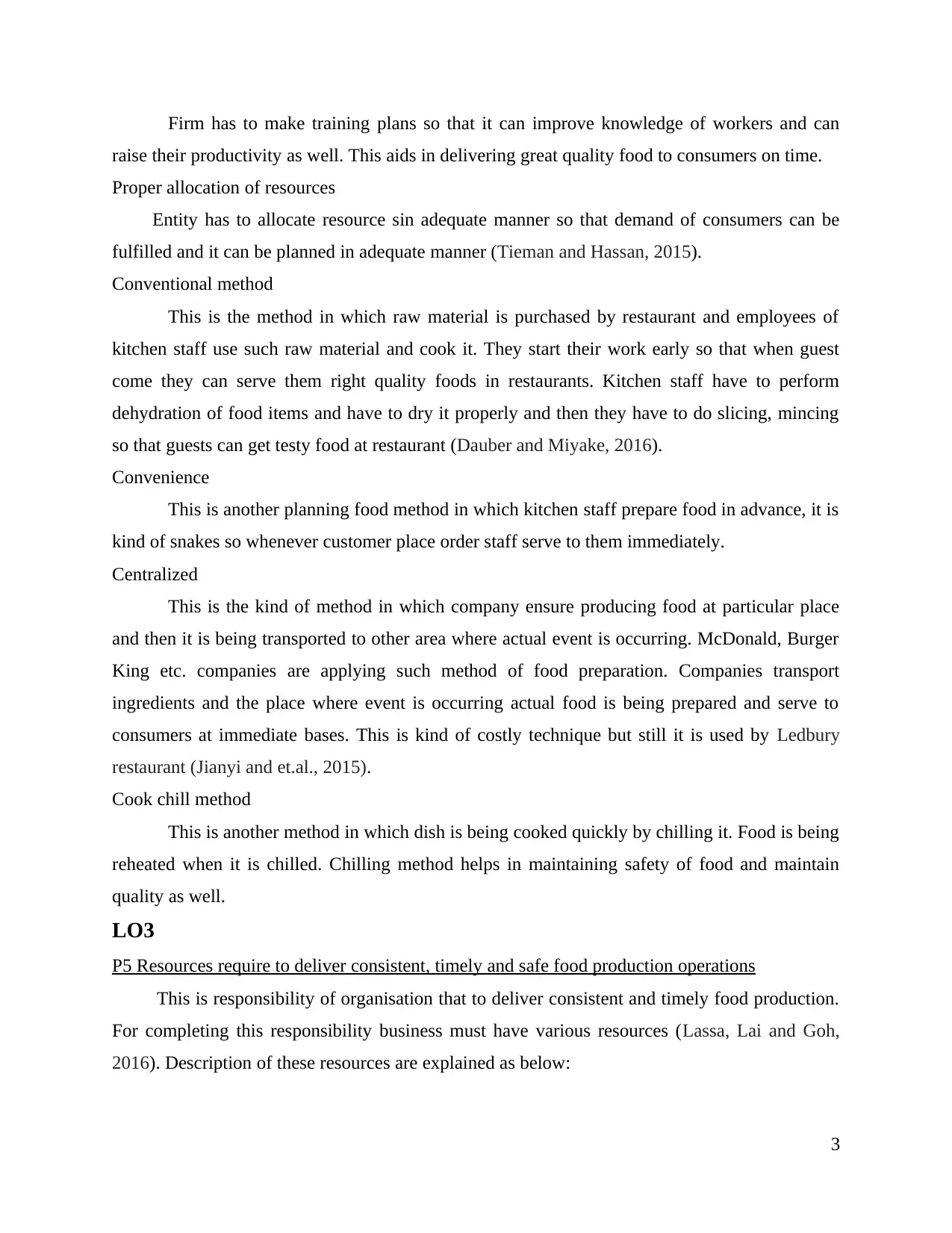
Firm has to make training plans so that it can improve knowledge of workers and can
raise their productivity as well. This aids in delivering great quality food to consumers on time.
Proper allocation of resources
Entity has to allocate resource sin adequate manner so that demand of consumers can be
fulfilled and it can be planned in adequate manner (Tieman and Hassan, 2015).
Conventional method
This is the method in which raw material is purchased by restaurant and employees of
kitchen staff use such raw material and cook it. They start their work early so that when guest
come they can serve them right quality foods in restaurants. Kitchen staff have to perform
dehydration of food items and have to dry it properly and then they have to do slicing, mincing
so that guests can get testy food at restaurant (Dauber and Miyake, 2016).
Convenience
This is another planning food method in which kitchen staff prepare food in advance, it is
kind of snakes so whenever customer place order staff serve to them immediately.
Centralized
This is the kind of method in which company ensure producing food at particular place
and then it is being transported to other area where actual event is occurring. McDonald, Burger
King etc. companies are applying such method of food preparation. Companies transport
ingredients and the place where event is occurring actual food is being prepared and serve to
consumers at immediate bases. This is kind of costly technique but still it is used by Ledbury
restaurant (Jianyi and et.al., 2015).
Cook chill method
This is another method in which dish is being cooked quickly by chilling it. Food is being
reheated when it is chilled. Chilling method helps in maintaining safety of food and maintain
quality as well.
LO3
P5 Resources require to deliver consistent, timely and safe food production operations
This is responsibility of organisation that to deliver consistent and timely food production.
For completing this responsibility business must have various resources (Lassa, Lai and Goh,
2016). Description of these resources are explained as below:
3
raise their productivity as well. This aids in delivering great quality food to consumers on time.
Proper allocation of resources
Entity has to allocate resource sin adequate manner so that demand of consumers can be
fulfilled and it can be planned in adequate manner (Tieman and Hassan, 2015).
Conventional method
This is the method in which raw material is purchased by restaurant and employees of
kitchen staff use such raw material and cook it. They start their work early so that when guest
come they can serve them right quality foods in restaurants. Kitchen staff have to perform
dehydration of food items and have to dry it properly and then they have to do slicing, mincing
so that guests can get testy food at restaurant (Dauber and Miyake, 2016).
Convenience
This is another planning food method in which kitchen staff prepare food in advance, it is
kind of snakes so whenever customer place order staff serve to them immediately.
Centralized
This is the kind of method in which company ensure producing food at particular place
and then it is being transported to other area where actual event is occurring. McDonald, Burger
King etc. companies are applying such method of food preparation. Companies transport
ingredients and the place where event is occurring actual food is being prepared and serve to
consumers at immediate bases. This is kind of costly technique but still it is used by Ledbury
restaurant (Jianyi and et.al., 2015).
Cook chill method
This is another method in which dish is being cooked quickly by chilling it. Food is being
reheated when it is chilled. Chilling method helps in maintaining safety of food and maintain
quality as well.
LO3
P5 Resources require to deliver consistent, timely and safe food production operations
This is responsibility of organisation that to deliver consistent and timely food production.
For completing this responsibility business must have various resources (Lassa, Lai and Goh,
2016). Description of these resources are explained as below:
3
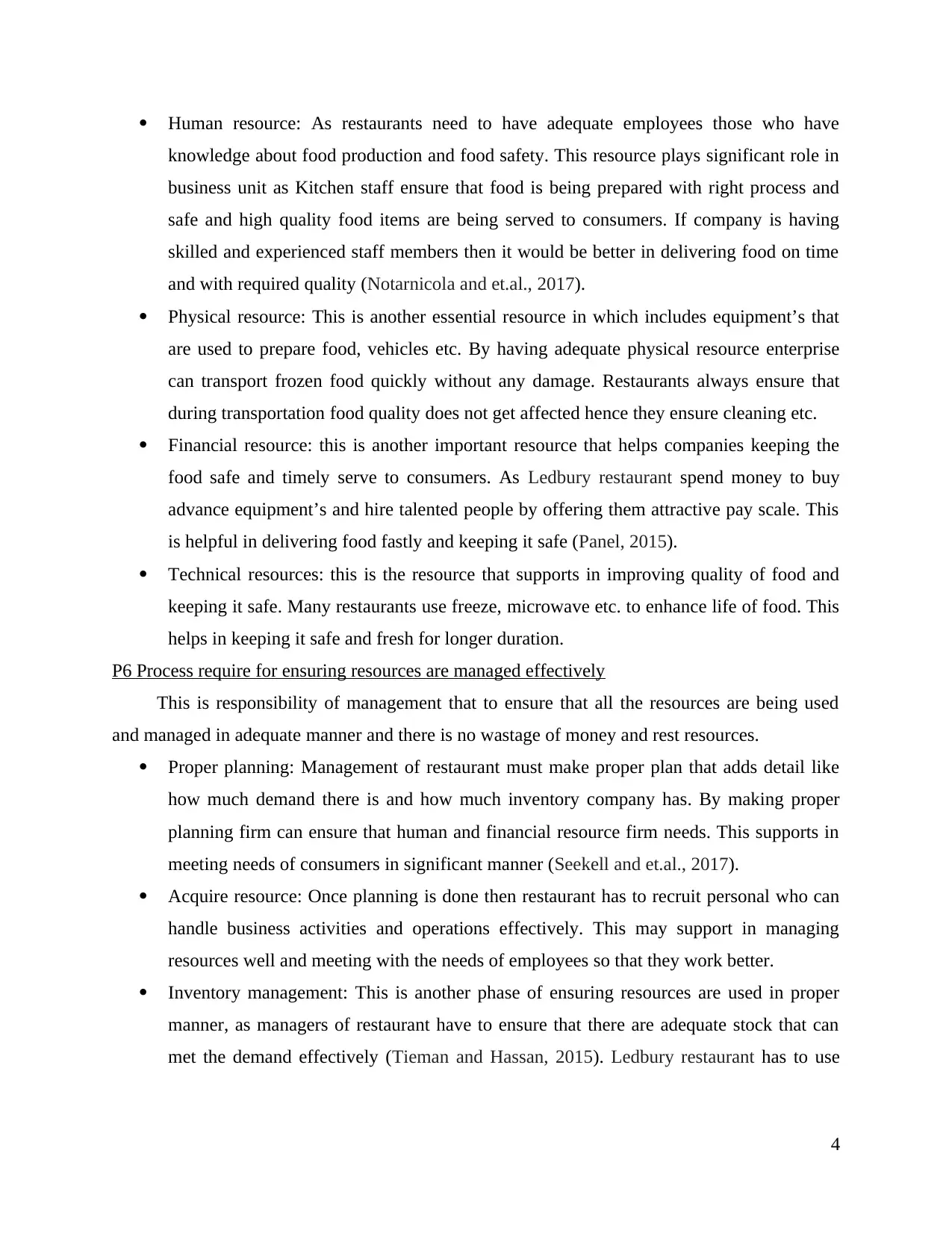
Human resource: As restaurants need to have adequate employees those who have
knowledge about food production and food safety. This resource plays significant role in
business unit as Kitchen staff ensure that food is being prepared with right process and
safe and high quality food items are being served to consumers. If company is having
skilled and experienced staff members then it would be better in delivering food on time
and with required quality (Notarnicola and et.al., 2017).
Physical resource: This is another essential resource in which includes equipment’s that
are used to prepare food, vehicles etc. By having adequate physical resource enterprise
can transport frozen food quickly without any damage. Restaurants always ensure that
during transportation food quality does not get affected hence they ensure cleaning etc.
Financial resource: this is another important resource that helps companies keeping the
food safe and timely serve to consumers. As Ledbury restaurant spend money to buy
advance equipment’s and hire talented people by offering them attractive pay scale. This
is helpful in delivering food fastly and keeping it safe (Panel, 2015).
Technical resources: this is the resource that supports in improving quality of food and
keeping it safe. Many restaurants use freeze, microwave etc. to enhance life of food. This
helps in keeping it safe and fresh for longer duration.
P6 Process require for ensuring resources are managed effectively
This is responsibility of management that to ensure that all the resources are being used
and managed in adequate manner and there is no wastage of money and rest resources.
Proper planning: Management of restaurant must make proper plan that adds detail like
how much demand there is and how much inventory company has. By making proper
planning firm can ensure that human and financial resource firm needs. This supports in
meeting needs of consumers in significant manner (Seekell and et.al., 2017).
Acquire resource: Once planning is done then restaurant has to recruit personal who can
handle business activities and operations effectively. This may support in managing
resources well and meeting with the needs of employees so that they work better.
Inventory management: This is another phase of ensuring resources are used in proper
manner, as managers of restaurant have to ensure that there are adequate stock that can
met the demand effectively (Tieman and Hassan, 2015). Ledbury restaurant has to use
4
knowledge about food production and food safety. This resource plays significant role in
business unit as Kitchen staff ensure that food is being prepared with right process and
safe and high quality food items are being served to consumers. If company is having
skilled and experienced staff members then it would be better in delivering food on time
and with required quality (Notarnicola and et.al., 2017).
Physical resource: This is another essential resource in which includes equipment’s that
are used to prepare food, vehicles etc. By having adequate physical resource enterprise
can transport frozen food quickly without any damage. Restaurants always ensure that
during transportation food quality does not get affected hence they ensure cleaning etc.
Financial resource: this is another important resource that helps companies keeping the
food safe and timely serve to consumers. As Ledbury restaurant spend money to buy
advance equipment’s and hire talented people by offering them attractive pay scale. This
is helpful in delivering food fastly and keeping it safe (Panel, 2015).
Technical resources: this is the resource that supports in improving quality of food and
keeping it safe. Many restaurants use freeze, microwave etc. to enhance life of food. This
helps in keeping it safe and fresh for longer duration.
P6 Process require for ensuring resources are managed effectively
This is responsibility of management that to ensure that all the resources are being used
and managed in adequate manner and there is no wastage of money and rest resources.
Proper planning: Management of restaurant must make proper plan that adds detail like
how much demand there is and how much inventory company has. By making proper
planning firm can ensure that human and financial resource firm needs. This supports in
meeting needs of consumers in significant manner (Seekell and et.al., 2017).
Acquire resource: Once planning is done then restaurant has to recruit personal who can
handle business activities and operations effectively. This may support in managing
resources well and meeting with the needs of employees so that they work better.
Inventory management: This is another phase of ensuring resources are used in proper
manner, as managers of restaurant have to ensure that there are adequate stock that can
met the demand effectively (Tieman and Hassan, 2015). Ledbury restaurant has to use
4
⊘ This is a preview!⊘
Do you want full access?
Subscribe today to unlock all pages.

Trusted by 1+ million students worldwide
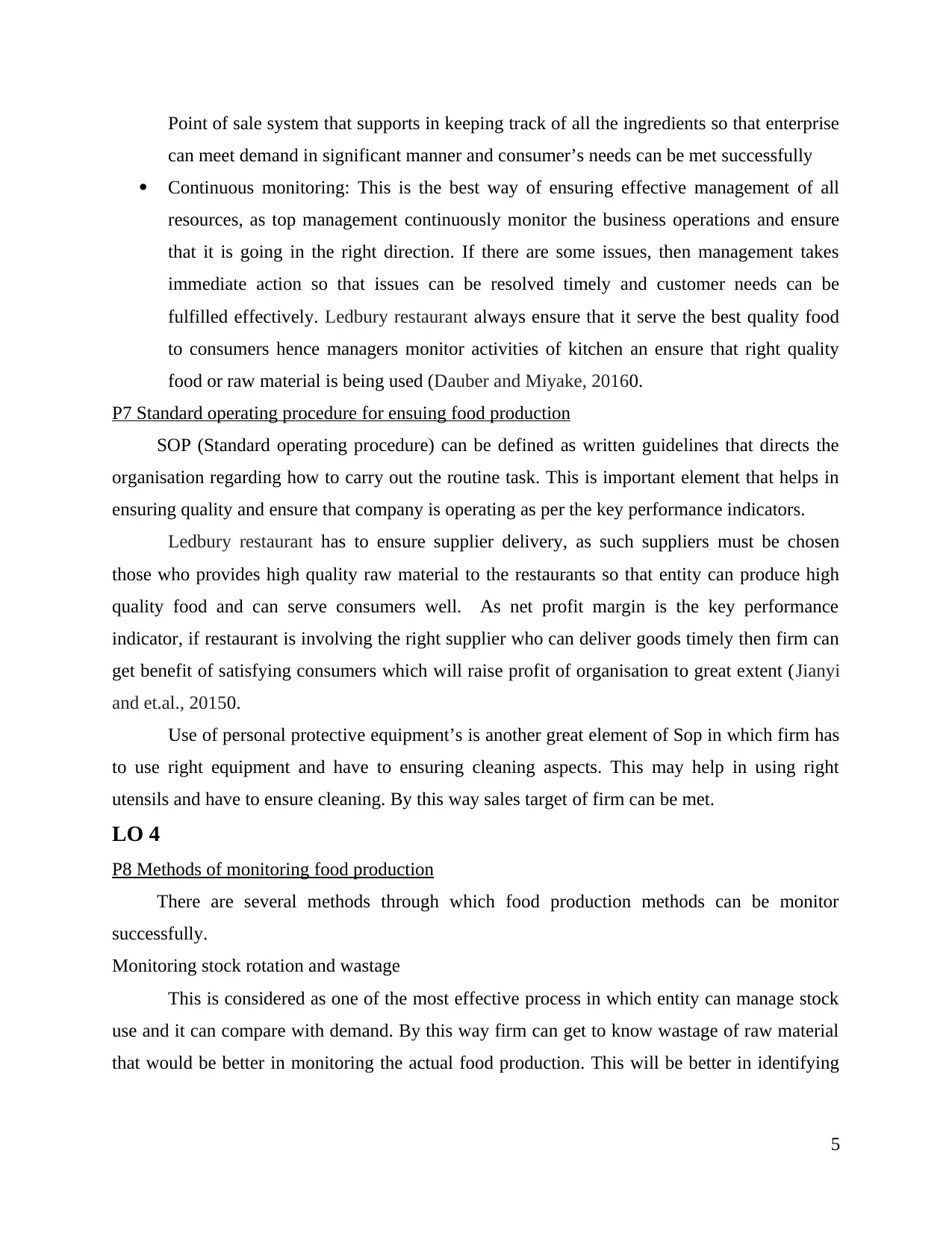
Point of sale system that supports in keeping track of all the ingredients so that enterprise
can meet demand in significant manner and consumer’s needs can be met successfully
Continuous monitoring: This is the best way of ensuring effective management of all
resources, as top management continuously monitor the business operations and ensure
that it is going in the right direction. If there are some issues, then management takes
immediate action so that issues can be resolved timely and customer needs can be
fulfilled effectively. Ledbury restaurant always ensure that it serve the best quality food
to consumers hence managers monitor activities of kitchen an ensure that right quality
food or raw material is being used (Dauber and Miyake, 20160.
P7 Standard operating procedure for ensuing food production
SOP (Standard operating procedure) can be defined as written guidelines that directs the
organisation regarding how to carry out the routine task. This is important element that helps in
ensuring quality and ensure that company is operating as per the key performance indicators.
Ledbury restaurant has to ensure supplier delivery, as such suppliers must be chosen
those who provides high quality raw material to the restaurants so that entity can produce high
quality food and can serve consumers well. As net profit margin is the key performance
indicator, if restaurant is involving the right supplier who can deliver goods timely then firm can
get benefit of satisfying consumers which will raise profit of organisation to great extent (Jianyi
and et.al., 20150.
Use of personal protective equipment’s is another great element of Sop in which firm has
to use right equipment and have to ensuring cleaning aspects. This may help in using right
utensils and have to ensure cleaning. By this way sales target of firm can be met.
LO 4
P8 Methods of monitoring food production
There are several methods through which food production methods can be monitor
successfully.
Monitoring stock rotation and wastage
This is considered as one of the most effective process in which entity can manage stock
use and it can compare with demand. By this way firm can get to know wastage of raw material
that would be better in monitoring the actual food production. This will be better in identifying
5
can meet demand in significant manner and consumer’s needs can be met successfully
Continuous monitoring: This is the best way of ensuring effective management of all
resources, as top management continuously monitor the business operations and ensure
that it is going in the right direction. If there are some issues, then management takes
immediate action so that issues can be resolved timely and customer needs can be
fulfilled effectively. Ledbury restaurant always ensure that it serve the best quality food
to consumers hence managers monitor activities of kitchen an ensure that right quality
food or raw material is being used (Dauber and Miyake, 20160.
P7 Standard operating procedure for ensuing food production
SOP (Standard operating procedure) can be defined as written guidelines that directs the
organisation regarding how to carry out the routine task. This is important element that helps in
ensuring quality and ensure that company is operating as per the key performance indicators.
Ledbury restaurant has to ensure supplier delivery, as such suppliers must be chosen
those who provides high quality raw material to the restaurants so that entity can produce high
quality food and can serve consumers well. As net profit margin is the key performance
indicator, if restaurant is involving the right supplier who can deliver goods timely then firm can
get benefit of satisfying consumers which will raise profit of organisation to great extent (Jianyi
and et.al., 20150.
Use of personal protective equipment’s is another great element of Sop in which firm has
to use right equipment and have to ensuring cleaning aspects. This may help in using right
utensils and have to ensure cleaning. By this way sales target of firm can be met.
LO 4
P8 Methods of monitoring food production
There are several methods through which food production methods can be monitor
successfully.
Monitoring stock rotation and wastage
This is considered as one of the most effective process in which entity can manage stock
use and it can compare with demand. By this way firm can get to know wastage of raw material
that would be better in monitoring the actual food production. This will be better in identifying
5
Paraphrase This Document
Need a fresh take? Get an instant paraphrase of this document with our AI Paraphraser
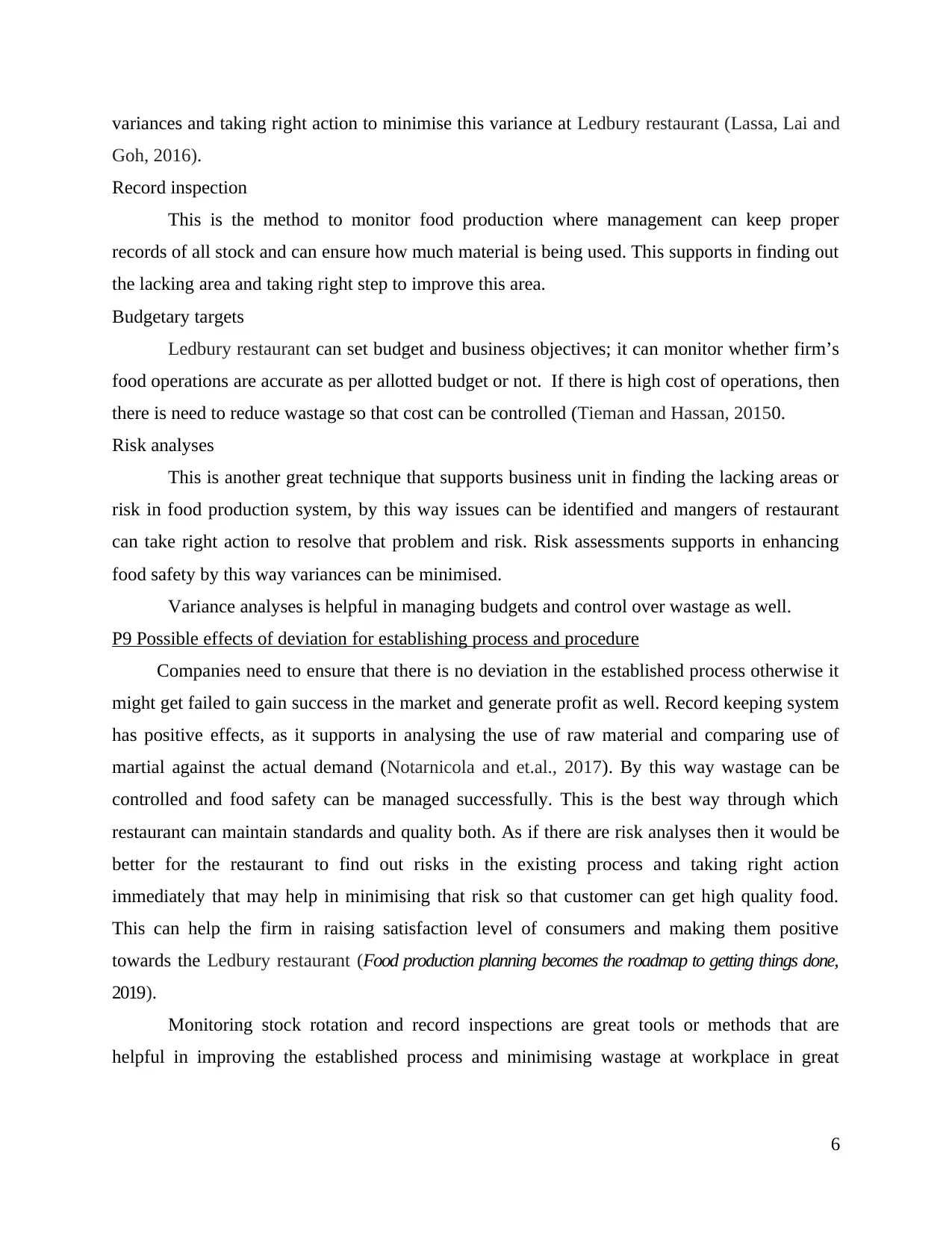
variances and taking right action to minimise this variance at Ledbury restaurant (Lassa, Lai and
Goh, 2016).
Record inspection
This is the method to monitor food production where management can keep proper
records of all stock and can ensure how much material is being used. This supports in finding out
the lacking area and taking right step to improve this area.
Budgetary targets
Ledbury restaurant can set budget and business objectives; it can monitor whether firm’s
food operations are accurate as per allotted budget or not. If there is high cost of operations, then
there is need to reduce wastage so that cost can be controlled (Tieman and Hassan, 20150.
Risk analyses
This is another great technique that supports business unit in finding the lacking areas or
risk in food production system, by this way issues can be identified and mangers of restaurant
can take right action to resolve that problem and risk. Risk assessments supports in enhancing
food safety by this way variances can be minimised.
Variance analyses is helpful in managing budgets and control over wastage as well.
P9 Possible effects of deviation for establishing process and procedure
Companies need to ensure that there is no deviation in the established process otherwise it
might get failed to gain success in the market and generate profit as well. Record keeping system
has positive effects, as it supports in analysing the use of raw material and comparing use of
martial against the actual demand (Notarnicola and et.al., 2017). By this way wastage can be
controlled and food safety can be managed successfully. This is the best way through which
restaurant can maintain standards and quality both. As if there are risk analyses then it would be
better for the restaurant to find out risks in the existing process and taking right action
immediately that may help in minimising that risk so that customer can get high quality food.
This can help the firm in raising satisfaction level of consumers and making them positive
towards the Ledbury restaurant (Food production planning becomes the roadmap to getting things done,
2019).
Monitoring stock rotation and record inspections are great tools or methods that are
helpful in improving the established process and minimising wastage at workplace in great
6
Goh, 2016).
Record inspection
This is the method to monitor food production where management can keep proper
records of all stock and can ensure how much material is being used. This supports in finding out
the lacking area and taking right step to improve this area.
Budgetary targets
Ledbury restaurant can set budget and business objectives; it can monitor whether firm’s
food operations are accurate as per allotted budget or not. If there is high cost of operations, then
there is need to reduce wastage so that cost can be controlled (Tieman and Hassan, 20150.
Risk analyses
This is another great technique that supports business unit in finding the lacking areas or
risk in food production system, by this way issues can be identified and mangers of restaurant
can take right action to resolve that problem and risk. Risk assessments supports in enhancing
food safety by this way variances can be minimised.
Variance analyses is helpful in managing budgets and control over wastage as well.
P9 Possible effects of deviation for establishing process and procedure
Companies need to ensure that there is no deviation in the established process otherwise it
might get failed to gain success in the market and generate profit as well. Record keeping system
has positive effects, as it supports in analysing the use of raw material and comparing use of
martial against the actual demand (Notarnicola and et.al., 2017). By this way wastage can be
controlled and food safety can be managed successfully. This is the best way through which
restaurant can maintain standards and quality both. As if there are risk analyses then it would be
better for the restaurant to find out risks in the existing process and taking right action
immediately that may help in minimising that risk so that customer can get high quality food.
This can help the firm in raising satisfaction level of consumers and making them positive
towards the Ledbury restaurant (Food production planning becomes the roadmap to getting things done,
2019).
Monitoring stock rotation and record inspections are great tools or methods that are
helpful in improving the established process and minimising wastage at workplace in great
6
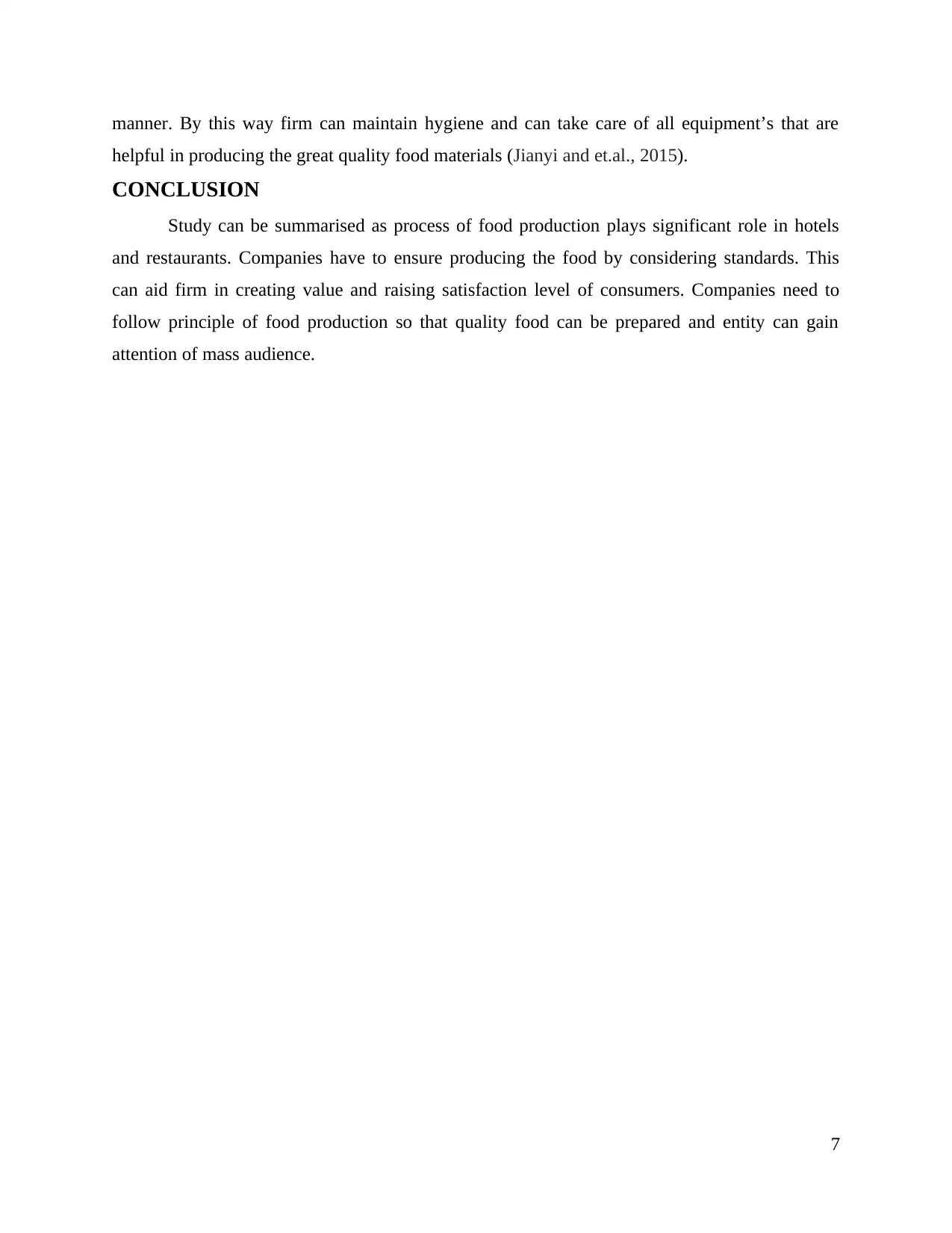
manner. By this way firm can maintain hygiene and can take care of all equipment’s that are
helpful in producing the great quality food materials (Jianyi and et.al., 2015).
CONCLUSION
Study can be summarised as process of food production plays significant role in hotels
and restaurants. Companies have to ensure producing the food by considering standards. This
can aid firm in creating value and raising satisfaction level of consumers. Companies need to
follow principle of food production so that quality food can be prepared and entity can gain
attention of mass audience.
7
helpful in producing the great quality food materials (Jianyi and et.al., 2015).
CONCLUSION
Study can be summarised as process of food production plays significant role in hotels
and restaurants. Companies have to ensure producing the food by considering standards. This
can aid firm in creating value and raising satisfaction level of consumers. Companies need to
follow principle of food production so that quality food can be prepared and entity can gain
attention of mass audience.
7
⊘ This is a preview!⊘
Do you want full access?
Subscribe today to unlock all pages.

Trusted by 1+ million students worldwide
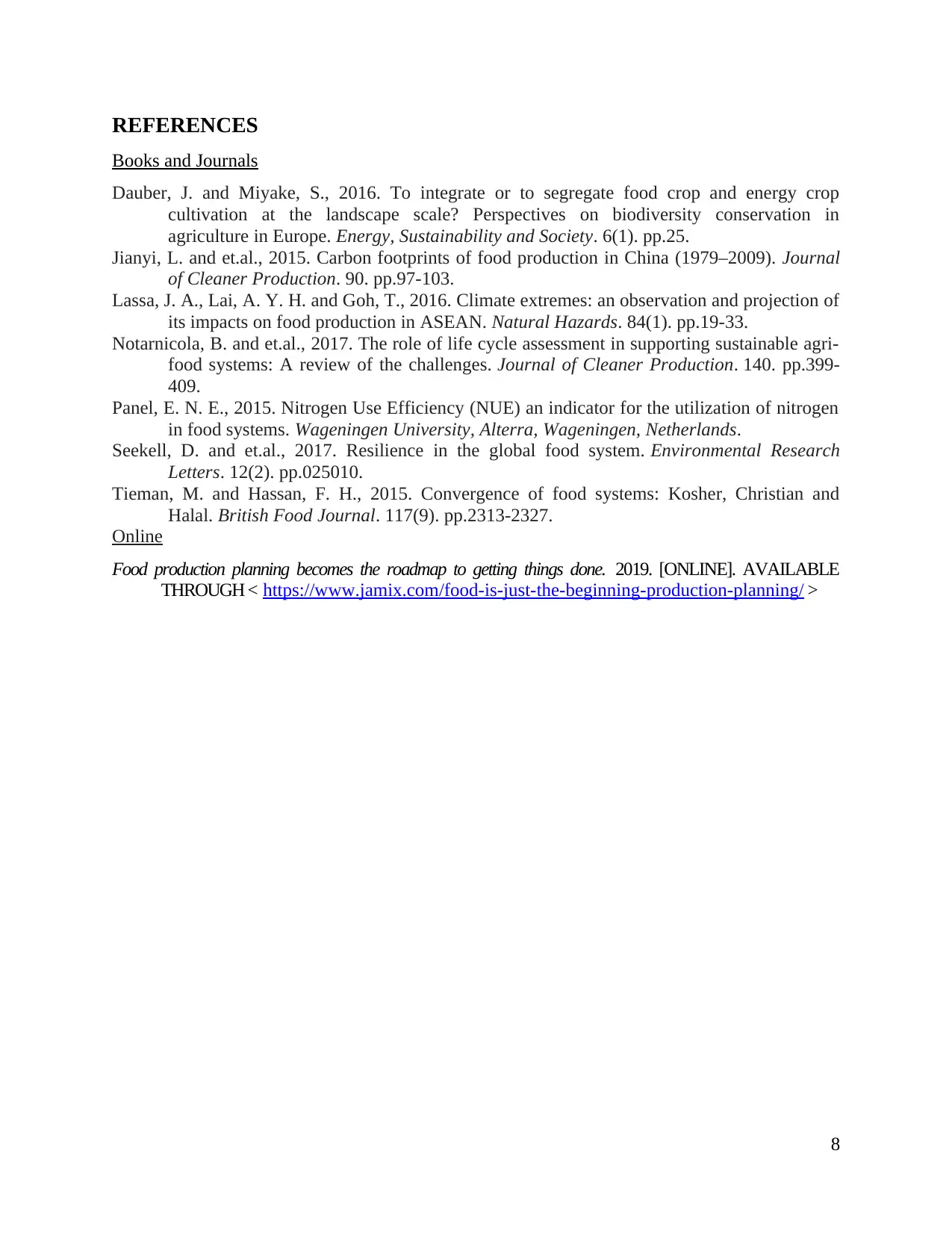
REFERENCES
Books and Journals
Dauber, J. and Miyake, S., 2016. To integrate or to segregate food crop and energy crop
cultivation at the landscape scale? Perspectives on biodiversity conservation in
agriculture in Europe. Energy, Sustainability and Society. 6(1). pp.25.
Jianyi, L. and et.al., 2015. Carbon footprints of food production in China (1979–2009). Journal
of Cleaner Production. 90. pp.97-103.
Lassa, J. A., Lai, A. Y. H. and Goh, T., 2016. Climate extremes: an observation and projection of
its impacts on food production in ASEAN. Natural Hazards. 84(1). pp.19-33.
Notarnicola, B. and et.al., 2017. The role of life cycle assessment in supporting sustainable agri-
food systems: A review of the challenges. Journal of Cleaner Production. 140. pp.399-
409.
Panel, E. N. E., 2015. Nitrogen Use Efficiency (NUE) an indicator for the utilization of nitrogen
in food systems. Wageningen University, Alterra, Wageningen, Netherlands.
Seekell, D. and et.al., 2017. Resilience in the global food system. Environmental Research
Letters. 12(2). pp.025010.
Tieman, M. and Hassan, F. H., 2015. Convergence of food systems: Kosher, Christian and
Halal. British Food Journal. 117(9). pp.2313-2327.
Online
Food production planning becomes the roadmap to getting things done. 2019. [ONLINE]. AVAILABLE
THROUGH < https://www.jamix.com/food-is-just-the-beginning-production-planning/ >
8
Books and Journals
Dauber, J. and Miyake, S., 2016. To integrate or to segregate food crop and energy crop
cultivation at the landscape scale? Perspectives on biodiversity conservation in
agriculture in Europe. Energy, Sustainability and Society. 6(1). pp.25.
Jianyi, L. and et.al., 2015. Carbon footprints of food production in China (1979–2009). Journal
of Cleaner Production. 90. pp.97-103.
Lassa, J. A., Lai, A. Y. H. and Goh, T., 2016. Climate extremes: an observation and projection of
its impacts on food production in ASEAN. Natural Hazards. 84(1). pp.19-33.
Notarnicola, B. and et.al., 2017. The role of life cycle assessment in supporting sustainable agri-
food systems: A review of the challenges. Journal of Cleaner Production. 140. pp.399-
409.
Panel, E. N. E., 2015. Nitrogen Use Efficiency (NUE) an indicator for the utilization of nitrogen
in food systems. Wageningen University, Alterra, Wageningen, Netherlands.
Seekell, D. and et.al., 2017. Resilience in the global food system. Environmental Research
Letters. 12(2). pp.025010.
Tieman, M. and Hassan, F. H., 2015. Convergence of food systems: Kosher, Christian and
Halal. British Food Journal. 117(9). pp.2313-2327.
Online
Food production planning becomes the roadmap to getting things done. 2019. [ONLINE]. AVAILABLE
THROUGH < https://www.jamix.com/food-is-just-the-beginning-production-planning/ >
8
1 out of 10
Related Documents
Your All-in-One AI-Powered Toolkit for Academic Success.
+13062052269
info@desklib.com
Available 24*7 on WhatsApp / Email
![[object Object]](/_next/static/media/star-bottom.7253800d.svg)
Unlock your academic potential
Copyright © 2020–2025 A2Z Services. All Rights Reserved. Developed and managed by ZUCOL.



